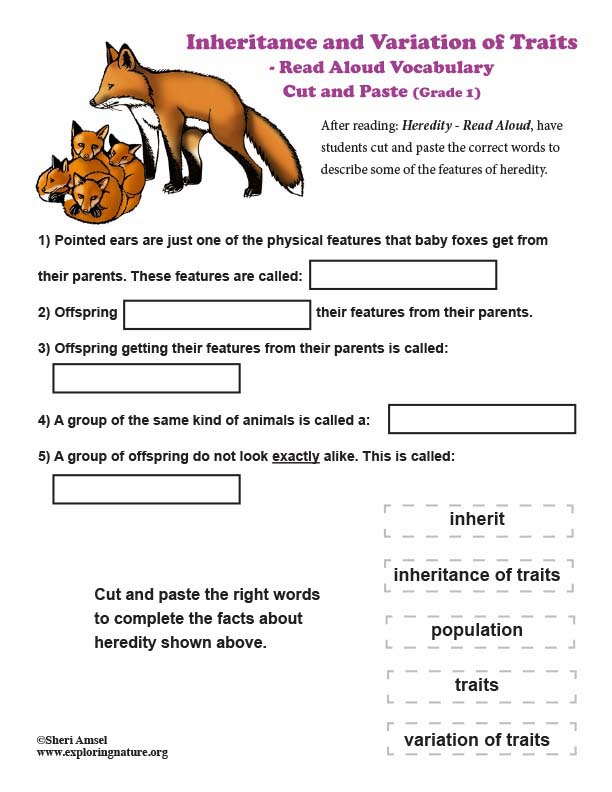

Animals and plants look like their parents. A red fox’s young will be reddish-colored like their parents. They each will have a fluffy tail with a white tip. They will have long, pointed ears and a pointed snout. They will have black socks, sharp teeth and claws. Each of those things about a red fox are called its traits.
Animals and plants get their traits from their parents. They inherit them. (This is called inheritance of traits.) Plants inherit traits too. A daisy inherits its yellow center, white petals and long stems from its parent plants.
Even though baby animals and plants get their traits from their parents, they do not look exactly like their parents. Beagle puppies may look like their parents with the same floppy ears and long tail, but they may have many differences too. They may have different colored or shaped spots. They may have smaller ears or a shorter tail. (This is called a variation of traits.)
In the same way, a group of the same kind of animals, called a population, may look alike but have many differences among them. For example, a herd of caribou may all have large antlers, big hooves and a thick coat of brown fur, but not all the caribou will be exactly the same. Some caribou may have bigger antlers or bigger feed or a lighter colored fur. (This is another example of the variation of traits.)
Disciplinary Core Ideas
LS3.A: Inheritance of Traits
• Young animals are very much, but not exactly like, their parents. Plants also are very much, but not exactly, like their parents. (1-LS3-1)
LS3.B: Variation of Traits
• Individuals of the same kind of plant or animal are recognizable as similar but can also vary in many ways. (1-LS3-1)
Science and Engineering Practices
Constructing Explanations and Designing Solutions
Constructing explanations and designing solutions in K–2 builds on prior experiences and progresses to the use of evidence and ideas in constructing evidence-based accounts of natural phenomena and designing solutions.
• Make observations (firsthand or from media) to construct an evidence-based account for natural phenomena. (1-LS3-1)
Crosscutting Concepts
Patterns
• Patterns in the natural and human designed world can be observed, used to describe phenomena, and used as evidence. (1-LS3-1)
Performance Expectations - Students who demonstrate understanding can:
1-LS3-1. Make observations to construct an evidence-based account that young plants and animals are like, but not exactly like, their parents. [Clarification Statement: Examples of patterns could include features plants or animals share. Examples of observations could include leaves from the same kind of plant are the same shape but can differ in size; and, a particular breed of dog looks like its parents but is not exactly the same.] [Assessment Boundary: Assessment does not include inheritance or animals that undergo metamorphosis or hybrids.]
When you research information you must cite the reference. Citing for websites is different from citing from books, magazines and periodicals. The style of citing shown here is from the MLA Style Citations (Modern Language Association).
When citing a WEBSITE the general format is as follows.
Author Last Name, First Name(s). "Title: Subtitle of Part of Web Page, if appropriate." Title: Subtitle: Section of Page if appropriate. Sponsoring/Publishing Agency, If Given. Additional significant descriptive information. Date of Electronic Publication or other Date, such as Last Updated. Day Month Year of access < URL >.
Amsel, Sheri. "Inheritance and Variation of Traits - Vocabulary Cut and Paste" Exploring Nature Educational Resource ©2005-2025. April 4, 2025
< http://www.exploringnature.org/db/view/Inheritance-and-Variation-of-Traits-Vocabulary-Cut-and-Paste >
